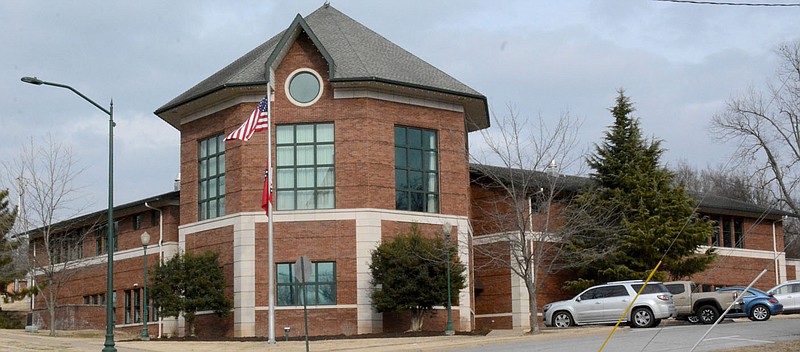SILOAM SPRINGS -- City directors heard the results of a utility rate study conducted by 1898 & Company during a workshop held prior to the city board meeting May 4.
Dave Naumann, senior project manager for 1898 & Company, presented the results. The city entered into a contract with 1898 & Company in November, according to City Administrator Phillip Patterson.
The study compared Siloam Springs' utilities with those of Bentonville, Fayetteville, Rogers and Springdale, Naumann said. Overall, the results from the study were positive, Naumann said.
"We've reached a couple of good milestones and that's what we'll be reporting on tonight," Naumann said.
The rate study analyzed the current utility rates for electric, sanitation, wastewater and water. Presently, the rates for the four utilities in Siloam Springs are driven by the consumer price index for electric and the consumer price index plus one percent for sanitation, wastewater and water, Naumann said.
The city has been raising rates per the consumer price index since 2013, according to the city's website. For the study, 1898 & Company focused mainly on residential customers.
Comparisons with the other cities show Siloam Springs has the highest rates for water, the second highest rates for electricity and sanitation, and third highest for wastewater.
Naumann, along with Electric Lead Adam Young, who did not appear in person but could be heard over the phone, took the board members through each utility and discussed possible increases to rates as well as how those increases would compare to the current utility bill.
When looking at each utility, 1898 & Company focused on operation and maintenance expense; transfers to the city; the capital improvement plan; debt payments; reserve deposits; and in the case of electric, purchased power, Naumann said.
Water has a relatively strong cash-flow and its debt will retire in 2022, Naumann said.
The consumer price index plus one percent-based adjustment would rise about $1 million by 2026 if the current rate increases continued, according to a slide show presentation from 1898 & Company. The city is also paying for about $300,000 to $700,000 annually in capital improvements as well as renewal and replacement, Naumann said.
Naumann recommended a rate increase of 0.75 percent annually for the next five years for water.
"We can meet those needs with something less than CPI," Naumann said. "It's a 0.75 percent increase as opposed to the CPI policy you've been following."
The debt for wastewater will retire in 2025, Naumann said. He also pointed out the cash-flow for wastewater is a little weaker, where wastewater will achieve less than $1 million annually and the city is funding $700,000 to $900,000 annually for capital sewer improvements.
For that reason, Naumann recommended a two percent increase annually, he said.
This utility is fairly healthy, Naumann said. The largest element of cost was purchase power which is between $10 million and $15 million annually with a funding cost of about $1.3 million in rate-funded improvements and renewal and replacement, the presentation states.
Electric does not have any outstanding debt, which helps with cash-flow, Naumann said. Based on the performance of this utility, 1898 & Company recommended an increase of only 0.75 percent annually.
The utility has a very small amount of debt, which will be retired in 2022, but there is a high gap between revenue and rates, Naumann said. Revenue requirements for this utility are also fairly large, which is why the recommended rate increase is four percent, Nauman said.
"We have a ramped recovery of that cash flow and it will be self-sufficient by 2026, but we're phasing that in," Naumann said.
Naumann showed the board a summary of the potential ratepayer impact for 2022. In this summary, the bill for 2022 would be 1.24 percent lower than the current consumer price index-based methodology the city presently uses. When adding all of the utility charges together, the amount the average ratepayer will pay under the current methodology would be almost $200 per month with an increase of almost $4 a month over the previous year's rates.
Under the proposed rate changes, the average ratepayer would pay around $198 per month with an increase of less than $3 a month, the summary states.
Directors had mixed reactions to the study. Director David Allen said he was surprised Naumann and his team only included the four major cities in Northwest Arkansas in their study and didn't include Bella Vista, which is closer to the size of Siloam Springs with a population of 28,539 as of 2019, according to the U.S. Census Bureau.
"It would be much more similar to compare us to (Bella Vista) than some of these other cities along the corridor," Allen said.
He also asked Naumann if there was any thought to looking at other cities around the state or region. Director Lesa Rissler echoed Allen's comments saying she would have preferred a more apple-to-apple comparison.
Director Mindy Hunt thanked Naumann for the information and said she found it very encouraging, but also wondered why only the four major cities of Northwest Arkansas were used.
"In my mind if we are the same rate or higher than the corridor, then we would potentially be significantly higher than other places in the state that are our size," Hunt said.
Director Brad Burns said the whole concept of the rate study is a response to members of the community that are concerned about their bills and that it stimulated good conversation in the board.
"This is the meat of the job and there are going to be some folks, no matter what we produce here, we're not going to get all smiles from everybody," Burns said.
